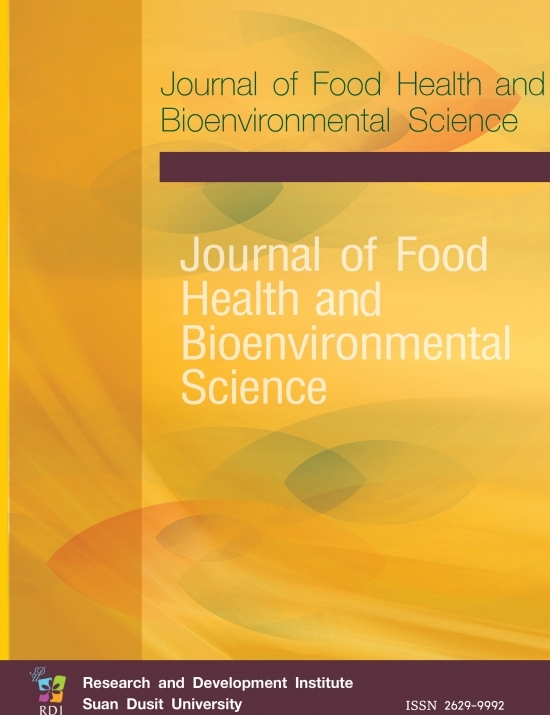Complementary Cancer Treatment at Wat Khampramong: Thai Traditional Healthcare
Keywords:
Complementary Cancer Treatment, Thai Traditional Healthcare, Wat Khampramong Sakon Nakhon ProvinceAbstract
The research documents the origin, practices and cultural format of Thai traditional healthcare in the Buddhist temple, Wat Khampramong, in Sakon Nakhon province and to study the cultural format of Thai traditional healthcare at that temple. The research is a qualitative study and the data analyzed through data triangulation method from data gathered from document analysis, field research data obtained from 25 research informants through the use of survey forms, interview forms, observation forms and from focus group discussions. The results found that the complementary healthcare treatment at Wat Khampramong consists of: 1. Modern medical treatment by licensed nurses who perform weekly blood samples of cancer patients, 2. Treatment by alternative methods, cancer treating herbal medicine, acupuncture and nutritional therapy, 3. Utilizing Buddhism principles through meditation, prayers, Chong Krom pacing therapy, Qigong aerobics, music and nature therapy and 4. Provide transfer service for critical patients to hospitals. The healthcare personnel at the temple include Phra Paponpatchara Jirathamo the abbot of Wat Khampramong working together with doctors, nurses, pharmacists and public health volunteers. The herbal medicine remedy for cancer treatment at the temple was created by Phra Paponpatchara Jirathamo during meditation in 2003. The complementary treatment at Wat Khampramong Temple provided opportunities for both the patient and their family to participate in religious activities at the temple and they also receive spiritual treatment which is an important factor affecting both the patients’ physical and mental fitness. The Buddhist prayers and sermons help create the proper and correct environment for patients in terminal situations and will lessen the impact of the fear of dying so that the patients are at peace. The complementary treatment also provides the patient with the strength to face the reality of death and live their final moments in peace and happiness.
References
Bar-Sela, G., Atid, L., Danos, S., Gabay, N., & Epelbaum, R. (2007). Art therapy improved depression and influenced fatigue levels in cancer patients on chemotherapy. Psycho-Oncology: Journal of the Psychological, Social and Behavioral Dimensions of Cancer, 16(11), 980- 984.
Cassileth, B.R., & Chapman, C.C. (1996). Alternative and complementary cancer therapies. Cancer: Interdisciplinary International Journal of the American Cancer Society, 77(6), 1026-1034.
Chimsut, T. (1998). Traditional medicine, Medical Care Karen (Southeast Asian People), Health and Hygiene (Master dissertation). Chiangmai: Chiangmai University.
Cutler, D., Kelly, D., & Silver, S. (2011). Creative homes: How the arts can contribute to quality of life in residential care. London, England: Baring Foundation.
Kataria, M. (2002). Laugh for no reason (2nd ed.). Mumbai, India: Madhuri International.
Khampramong. (2019). Khampramong & Arokhayasala [English Version]. Retrieved from http://khampramong.org/khampramong_eng.html
Kuiper, N.A., Martin, R.A., & Olinger, L.J. (1993). Coping humour, stress, and cognitive appraisals. Canadian Journal of Behavioural Science/Revue canadienne des sciences du comportement, 25(1), 81.
Khattiya, N. (2006). Traditional medical care and treatment of the Lua hill tribe: A case study of Baanmai Shanjarern Phatung district, Maejan district, Chiangrai province. (Master dissertation). Retrieved from http://cuir.car.chula.ac.th/handle/123456789/19167
Moore, A., & Malinowski, P. (2009). Meditation, mindfulness and cognitive flexibility. Consciousness and cognition, 18(1), 176-186.
Piew-on, C. (2011). The management of holistic end of life care for the end stage cancer patients: a case study Wat Kampramong, Sakonnakhon Province (Doctoral dissertation). Bangkok: Mahachulalongkornraja vidyalaya University.
Poonthananiwatkul, B., Howard, R.L., Williamson, E.M., & Lim, R. H. (2016). Why cancer patients choose in-patient complementary therapy in palliative care: A qualitative study at Arokhayasala Hospice in Thailand. European Journal of Integrative Medicine, 8(3), 260-265
Poonthananiwatkul, B., Lim, R.H., Howard, R.L., Pibanpaknitee, P., & Williamson, E.M. (2015). Traditional medicine use by cancer patients in Thailand. Journal of ethnopharmacology, 168, 100-107.
Richardson, M.A., Sanders, T., Palmer, J.L., Greisinger, A., & Singletary, S.E. (2000). Complementary/alternative medicine use in a comprehensive cancer center and the implications for oncology. Journal of Clinical Oncology, 18(13), 2505-2514.
Tascilar, M., de Jong, F.A., Verweij, J., & Mathijssen, R.H. (2006). Complementary and alternative medicine during cancer treatment: beyond innocence. The oncologist, 11(7), 732-741.
Wasi, P. (2009). IN48-WE-01 Brain and meditation. Journal of the Neurological Sciences, 285, S36. Xiong, X., Wang, P., Li, X., & Zhang, Y. (2015). Qigong for hypertension: a systematic review. Medicine, 94(1), e352.
Yim, J. (2016). Therapeutic benefits of laughter in mental health: a theoretical review. The Tohoku journal of experimental medicine, 239(3), 243-249.
Zhao, F., Lin, Y., Zhai, L., Gao, C., Zhang, J., Ye, Q., ... Liang, C. (2018). Effects of cardiac rehabilitation qigong exercise in patients with stable coronary artery disease undergoing phase III rehabilitation: A randomized controlled trial (with video). Journal of Traditional Chinese Medical Sciences, 5(4), 420-430.
Downloads
Published
How to Cite
Issue
Section
License

This work is licensed under a Creative Commons Attribution-NonCommercial-NoDerivatives 4.0 International License.








